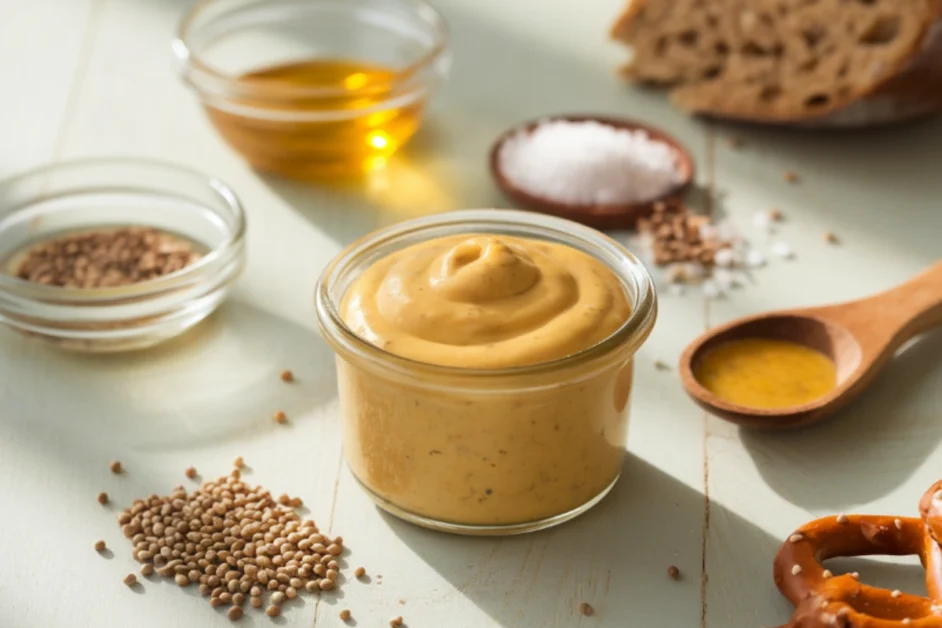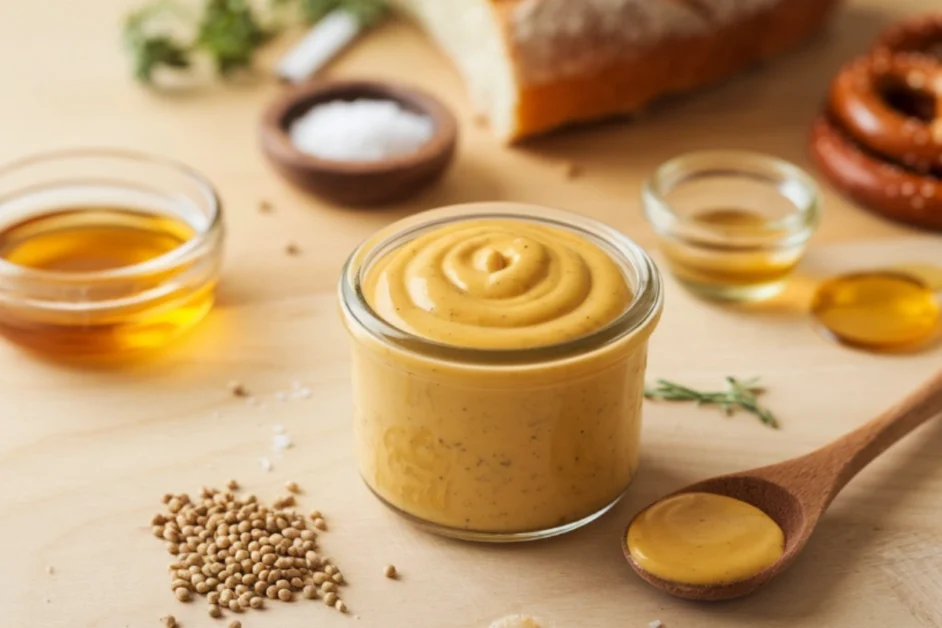Mustard sauce is a versatile and flavorful addition to many dishes. It has been a staple in kitchens around the world for centuries. But what is mustard sauce made of? This simple question opens the door to a rich world of culinary possibilities. Let’s explore the essential components and variations of this classic sauce.
Introduction
At its core, mustard sauce is a combination of a few key ingredients. These ingredients work together to create the tangy, spicy, and sometimes sweet flavor that makes this sauce so beloved. The primary components are mustard seeds, vinegar, and salt. From there, the possibilities expand, depending on the desired flavor profile and culinary tradition.
Basic Ingredients
The foundation of any mustardsauce is, of course, mustard seeds. These seeds come in various types, including yellow, brown, and black. Each type offers a different intensity of flavor, with yellow mustard seeds being the mildest and black mustard seeds the most pungent.
Next, vinegar is crucial. It adds acidity, which balances the heat of the mustard seeds. You can use different kinds of vinegar, such as white, apple cider, or white wine vinegar, to achieve various flavors.
For those who want to explore a more detailed recipe, the Mustard Sauce Recipe provides an excellent starting point.
Variations
While the basic ingredients remain consistent, there are countless variations of mustard sauce. These variations often reflect regional preferences and the specific dish you’re preparing. For instance, some recipes include sweeteners like honey or sugar to create a balance between sweet and tangy.
Others might incorporate spices like garlic, cayenne pepper, or herbs to add depth and complexity. Each addition brings a unique twist to the traditional sauce, making it a versatile condiment.
Types of Mustard Sauce
There are several types of this sauce, each with its own distinctive flavor and use. Here’s a look at some of the most popular varieties:
Yellow Mustard Sauce
Yellow sauce is perhaps the most common type. It’s made from yellow mustard seeds, vinegar, and turmeric, which gives it that bright yellow color. This type of this sauce is often used on hot dogs and sandwiches, adding a mild and tangy flavor that complements a variety of foods.
Dijon Mustard Sauce
Brown mustard seeds and wine or wine vinegar are used to make Dijon sauce. This version is more complex and intense than yellow mustard, making it a popular choice for salad dressings and marinades. The inclusion of wine gives Dijon mustard a unique, sophisticated taste.
For a quick and easy version, the 5 Minute Honey Mustard Sauce by Pinch of Yum is an excellent example of how to incorporate Dijon mustard into a versatile sauce.
Honey Mustard Sauce
Honey mustard sauce combines the sharpness of mustard with the sweetness of honey. You make it with mustard, honey, mayonnaise, and vinegar. People often use this sauce as a dipping sauce or salad dressing, offering a perfect balance of sweet and tangy flavors.
Spicy Brown Mustard Sauce
Spicy brown mustard sauce is made using coarse mustard seeds and additional spices. This type of mustard has a bold, intense flavor that’s perfect for deli sandwiches and sausages. The texture is also coarser, giving it a more rustic feel.
Mustard Cream Sauce
Mustard cream sauce is a richer, creamier version of this sauce. It’s made by combining mustard with heavy cream, garlic, and herbs. This sauce is often used to accompany fish or chicken dishes, adding a luxurious texture and flavor.
How to Make Mustard Sauce at Home
Making it at home is surprisingly easy. Here’s a simple recipe to get you started:
Basic Recipe
- Ingredients:
- 1/4 cup mustard seeds
- 1/4 cup vinegar (white or apple cider)
- 1/4 cup water
- 1/2 teaspoon salt
- 1 teaspoon sugar (optional for sweetness)
- Instructions:
- Combine the mustard seeds, vinegar, and water in a small bowl. Let it sit for a few hours to allow the flavors to meld.
- Blend the mixture until smooth. If you prefer a coarser texture, blend it for a shorter time.
- Add salt and sugar, adjusting to taste.
- Store the sauce in a jar and refrigerate for up to a week.
You can easily modify this basic recipe. You can add honey for a sweeter version or cayenne pepper for a spicy kick.
Mustard Sauce in Different Cuisines
it’s not just a Western condiment. It has found its way into cuisines around the world, each adapting the basic recipe to suit local tastes.
Mustard Sauce in American Cuisine
In the United States, it’s a key ingredient in BBQ sauces, sandwich spreads, and salad dressings. It’s a staple at cookouts and picnics, where it adds a burst of flavor to grilled meats and vegetables. For example, in a sloppy joe recipe, sauce adds a tangy element that enhances the overall taste.
Mustard Sauce in French Cuisine
In France, people often use it in vinaigrettes and as a component of classic dishes like Coq au Vin. Dijon mustard, in particular, is a staple in French cooking, providing a rich, tangy flavor that enhances both simple and complex dishes.
Mustard Sauce in Indian Cuisine
In India, people often use mustard in its whole seed form, but it’s also popular in other forms. Mustard oil and mustard seeds are common in curries and pickles, offering a robust, spicy flavor that’s integral to many regional dishes. It’s also featured in exotic recipes that highlight the versatility of mustard.
Mustard Sauce in Asian Cuisine
In Asian cuisine, people often use it as a dipping sauce, particularly in Chinese and Japanese cooking. It provides a sharp contrast to the rich, savory flavors of soy sauce and sesame oil.
Frequently Asked Questions (FAQs)
What are the basic ingredients of mustard sauce?
The basic ingredients include mustard seeds, vinegar, and salt. You can adjust these components to create different variations.
Can it be made without vinegar?
Yes, it can. Some recipes substitute vinegar with lemon juice or wine for a different flavor profile.
What is the difference between yellow mustard and Dijon mustard?
Yellow mustard has a milder flavor, as it is made with yellow mustard seeds and vinegar, while Dijon mustard offers a more complex taste, being made with brown mustard seeds and wine or wine vinegar.
How long does it last?
Homemade sauce can last up to a week in the refrigerator if stored in an airtight container.
Can it be frozen?
Yes, you can freeze it, though it may lose some of its texture and flavor when thawed.
you might also want to read this article about What Are the Main Ingredients in Sloppy Joe?.
Conclusion
In conclusion, you can adapt this versatile condiment to suit any taste. Whether you prefer the tangy bite of yellow mustard, the complexity of Dijon, or the sweetness of honey mustrd, there’s a version of this sauce for every palate. Making it at home allows you to experiment with flavors and find the perfect balance that suits your dishes.
So, next time you’re in the kitchen, don’t hesitate to whip up your own sauce. It’s simple, quick, and adds a world of flavor to any meal. For those who want to try making yellow mustard from scratch, Homemade Yellow Mustard by Leite’s Culinaria is an excellent resource to get started.

